Praia do Cassino
Praia do Cassino (Portuguese for Casino Beach) is the longest sea beach in the world[1] and is located in the southernmost of the Brazilian coast (33°07′34″S 52°38′22″W), on the South Atlantic Ocean, in the state of Rio Grande do Sul. It is the longest uninterrupted sandy seashore in the world, with various sources measuring it from 212 kilometres (132 mi)[2] to 254 kilometres (158 mi),[3][4][5] stretching from the Molhes (breakwaters) at the entrance of the Rio Grande seaport in the north to the mouth of the Chuí Stream, on the border with Uruguay, in the south.
| Praia do Cassino | |
|---|---|
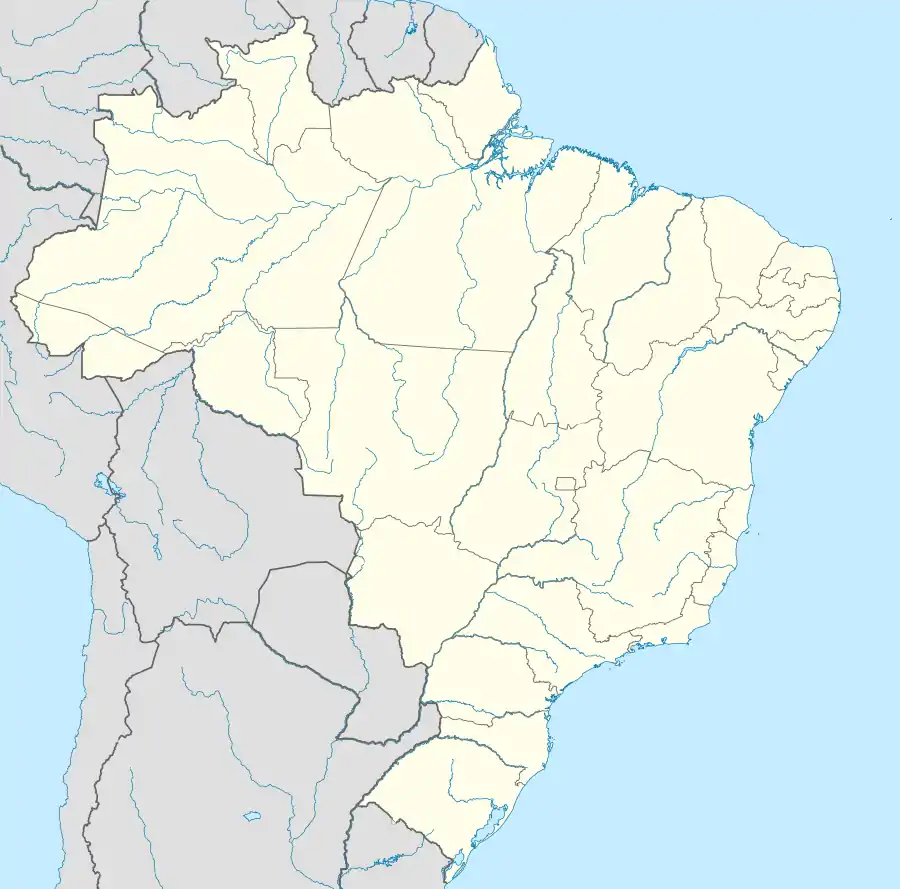 | |
| Location | Rio Grande do Sul, Brazil |
| Coordinates | 33.126080°S 52.639327°W |
| Offshore water bodies | South Atlantic Ocean |
| Length | 212 km |
| Geology | Beach |
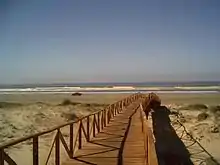
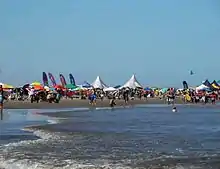
Etymology
The word Cassino comes from the Portuguese word Cassino which means Casino in English.[6] The beach is named Casino Beach as tourists used to gamble in luxury hotels situated at the beach area.
History
Cassino Beach is known as the oldest spa in Brazil, dating back to 1890. The beach was developed by the Suburban Mangueira Company as a tourist destination.[7] The director of the company, Antonio Condido Sequeira, and the investors of the company acquired the land in the beach area with the help of the state government and built a tourist complex on January 26, 1890. Later this tourist center became very popular and big companies started investing here. At the time, Brazilians of German, English, Portuguese, and Italian descent often came to the beach to enjoy the sea in expensive hotels. The persecution of Italians and Germans during World War II and the ban on roulette in 1948 had a devastating effect on the region's economy. However, in recent times Praia do Cassino have been able to attract tourists to the beach.
On Nov. 12, 1966, during a total solar eclipse visible in Praia do Cassino, NASA scientists and U.S. Army have launched several rockets to study upper atmosphere.[8]
The Praia do Casino was recognized as the longest beach in the world by Guinness World Records in 1994.[9][10]
The largest beach ultramarathon race in the world is held on this beach, the Cassino Ultra Race, a long-distance race that consists of traveling a distance of 230 km through the sand, although it can also be run in the 73K and 135K modality.[11] It begins at Barra del Chuí Beach and ends at Cassino Beach.[12]
Tourism
Around 150,000 tourists visit Praia do Cassino every year. During the summer season, especially from December to January, the number of tourists visiting this place increases. Tourists can be seen participating in various activities including swimming and surfing. This beach is home to the largest number of seals in the world. Many tourists visit these seals by boat.[13]
Tourist attractions
West Jetty
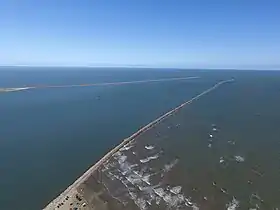
At the extreme point of the beach, a jetty was built with tons of stones that invade the open sea. Its formation, along with the Molhe Leste, on the other side of the navigation channel, protects the entry and exit of ships to the Rio Grande. At Molhe Oeste it is possible to take a cart, powered by sail, which slowly slides along the tracks into the ocean until it reaches the lighthouse tower. The trip takes about 20 minutes and covers a length of 4.3 kilometers. On the way you can still be lucky enough to see dolphins and grebes.
The resort has a carnival that brings together hundreds of people, with several carnival groups brightening up this resort-neighborhood.
Stranded ship
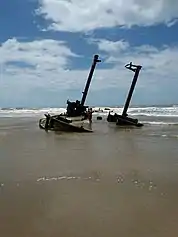
Sixteen kilometers from the center of the Casino towards Chuí, the ship Altair has been stranded on the edge of the beach since June 1976, after facing a strong storm.[14][15]
Yemanja statue
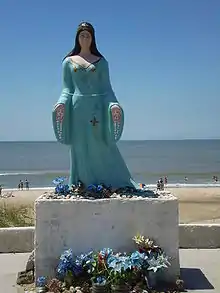
This sculpture is located in front of the sea at the entrance to Rio Grande Avenue. The artist was Rio-Grandio Erico Gobbi who made this sculpture with cement.[16]
Gallery
 Beach area
Beach area Tourists in the beach area
Tourists in the beach area Boat transport vehicles
Boat transport vehicles Barbecue at Cassino
Barbecue at Cassino Altair ship
Altair ship
References
- Zobel, Gibby (18 July 2014). "Brazilian artist makes sculptures from whalebones". BBC News.
- Nogueira, Kiko (2007). Guia Quatro Rodas Praias 2007 (in Portuguese). São Paulo: Editora Abril.
- Susin, Raquel (February 16, 2007). "Maior praia do Brasil" (in Portuguese). Rank Brasil. Retrieved 18 July 2010.
- Hueck, Karin; Miranda, Fabricio; Cohen, Otavio; Iria, Luiz; Garcia, Marcelo (May 2013). "No limite do Brasil: conheça melhor as fronteiras do país". Superinteressante (in Portuguese). Grupo Abril. Archived from the original on 26 July 2013. Retrieved 12 March 2014.
- "The Longest Beaches In The World". WorldAtlas. Retrieved 2019-11-13.
- "Cassino definition and meaning". Collins English Dictionary.
- Enke, Rebecca Guimarães (2005-04-19). "Balneário Villa Sequeira: a invenção de um novo lazer (1890-1905) Rio Grande, RS, Brasil" (in Brazilian Portuguese).
- "NASA SOUNDING ROCKET RESURGENGE 1965-1968". history.nasa.gov. Retrieved 2019-11-13.
{{cite web}}: CS1 maint: url-status (link) - The Guinness Book of Records 1994 (Guinness World Records).
- "The largest beach in the world! | Praia do Cassino in Rio Grande do Sul". BBMAG | International Lifestyle Magazine. 20 January 2017.
- Ticktogra (22 August 2021). "Cassino Ultra Race 230km a maior ultra maratona de paraia do mundo". Retrieved 7 December 2021.
- Tracedetrail (29 April 2018). "Cassino Ultra Race". Retrieved 7 December 2021.
- "Praia Do Cassino Beach, Brazil - Unique Places Around The World". World Atlas.
- "Prefeitura do Rio Grande > Atrativos Turísticos - Navio Altair". www.riogrande.rs.gov.br (in Brazilian Portuguese). Retrieved 2020-02-19.
- "Navio Altair: guardiões preservam a história do cargueiro". Grupo Oceano (in Brazilian Portuguese). Retrieved 2020-02-19.
- "Tourist attractions: Statue of Iemanjá" (in Brazilian Portuguese). Retrieved 20 October 2020.
External links
- Website of City Hall, Rio Grande (in Portuguese)
- Rio Grande do Sul Secretariat of Tourism (in Portuguese)
| Wikimedia Commons has media related to Praia do Cassino. |